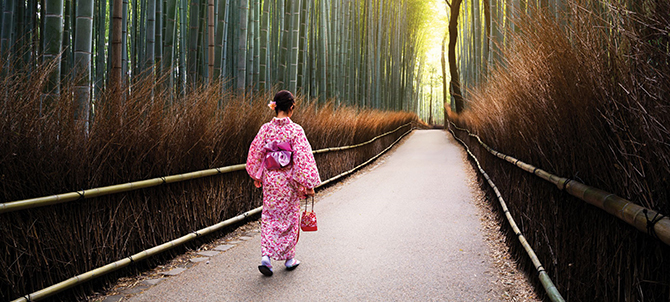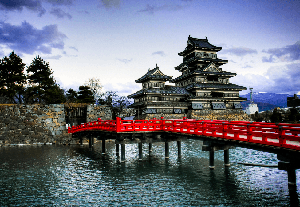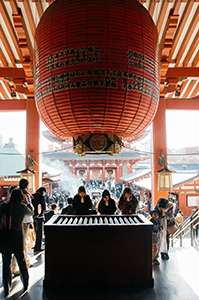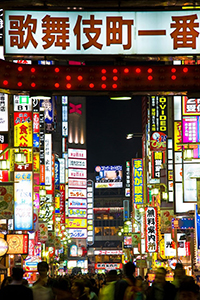TOKYO Serene Days, Electric Nights

By Michael Alpiner
For travelers eager to understand why Tokyo will be the site of the 2020 Summer Olympics, a deep dive into the culture and tradition of the Land of the Rising Sun is just about mandatory. Japan’s capital beat out Istanbul in the final decision-making round to become the first Asian city to host the Olympic Games twice.
Like so many destinations, Japan is looking to connect its tourists with both travel experiences that eclipse all others, as well as learning experiences that encourage Japanese cultural and historical awareness.

WHAT TO SEE & DO
This can be achieved in the open air through the exploration of Japan’s many monuments and museums dedicated to its rich history. For instance, The Imperial Palace, now the current residence of the Japanese Imperial Family, offers tourists an impressive view of the grounds (visitors are not allowed inside the palace). Likewise, Hiroshima Peace Memorial Museum attracts native Japanese and tourists to walk the solemn path of history. Though the main building is currently closed for renovations and is set to re-open in the spring of 2019, the East building is open and vibrant with artifacts and videos that inform and inspire visitors to self-reflect.
Another memorable excursion for travelers to Japan is a trek up Mount Takao the most visited mountain in the world. Not only will one discover outstanding natural elements, but a visit to Mount Takao also celebrates the two main religions of Japan, Shinto, and Buddhism. A fifty-minute train ride from Shinjuku on the Keio line brings tourists to the base of the mountain where souvenirs and snacks are available as an energy boost for the semi-formidable uphill climb taken by the 2.6 million people who visit Mount Takao annually.
AN UPHILL CLIMB
To scale Mount Takao, most tourists utilize the cable car which is only a five-minute scenic walk from the Takaosanguchi Station. The cable car is necessary as the incline is the steepest in all Japan at 31 degrees. The path is lined by intermittent lanterns and ema boards that celebrate the people and organizations who have contributed to the maintenance of the grounds. Along the way, travelers eventually encounter a torii, the gateway to a Shinto shrine. An open courtyard framed by Japanese-style edifices and majestic trees creates the natural stage which culminates to a Shinto shrine where hands are washed, and coins are offered up for prayers.

Ravens dominate the sky, caw and croak, adding gothic tone to the black and grey pavement. Statues of Tengu, the Buddhist and Shinto slayer of vanity in Japanese folk culture, greet visitors as they proceed up the mountain to the Buddhist temple. There, one can witness a fire ceremony, and drift into a rapturous trance amidst the gongs and drums, the chants of the Buddhist priests, and the crowds of followers lined up with a palm full of ground herbs to present to the deities. One can even eat like a monk at the head temple Takao-san Yakou-in, located near the Buddhist temple on Mount Takao. The food is all vegetarian and delicious, many of the dining areas are private, and the atmosphere is thoroughly authentic.
Back at sea level, or thereabouts, and after a rest from the fresh mountain air, travelers will not be at a loss for shopping, dining or nightlife. Retail stores are everywhere and often occupy whole multi-level buildings. On the ground floor, merchandise spills out onto the street drawing shoppers in through elaborate billboards and marquis, and even some stores employ young ladies dressed even more youthful with a megaphone in one hand (and of course a cell phone in the other), coaxing customers to enter the commercial paradise. Bright colors, neon lights, anime characters or photo-shopped models looking like a superhero fellowship are the typical marketing angles.
BEST STAY
But for that more up-scale Japanese cultural experience, tourists must stay at the Keio Plaza Hotel (keioplaza.co.jp) in downtown Shinjuku. Open since 1971; the hotel offers exceptional service and posh accommodations. Some rooms are economical in size but large in amenities. For instance, a standard room provides guests their own Smartphone for making international calls or even Google maps for exploring the city (good idea since there are few street signs to guide the visiting pedestrian). There are stunning views of the metropolitan expanse, and, on a clear day, a view of Mount Fuji in the distance.

The suites are roomy and luxurious with beautiful artistic elements (Muhammad Ali once stayed in one of the suites during his visit in the 70s for a boxer-wrestler exhibition). Another set of rooms are structured to accommodate larger families with as many as four separate beds in one small space, purely Japanese. For more traditional experiences, one can stay in a Tatami room, where the plush furnishings are exchanged for the beauty of simplicity, and the tranquility of the mind replaces corporal indulgence—a purely Zen experience.
The hotel proudly offers a menu of cultural experiences as well. Guests can partake in instructional sessions where they learn flower arrangement and tea ceremonies from trained experts in their respective fields. One can indulge in spa treatments while sporting a yukata, a thin robe tied at the waist, akin to a kimono. Also, the restaurants offer traditional dining experiences that stimulate the palate as boldly as it stimulates the mind. Sushi has never tasted so good as it does in Kyubey where master chefs prepare the delicacy with care and incredible flavors. This is only one of about twenty dining experiences available at the hotel.
One can write volumes about the tastes, sights, sounds, and culture of Japan. It is as much a cool destination as it is a way of thinking, a way of prioritizing one’s life. A lesson one can learn from a series of visits, or perhaps only one visit is that joy comes from caring about the comfort of others, and trusting that it becomes a universal way of life. It is expressed in the chants of the Buddhist monks, in the soft voices of the beautiful waitresses, in the bows of the concierge and the tacit arigatou acknowledging my presence, in the care taken to make my Japan experience as simple and enjoyable as possible. Precision is tantamount to respect, and selflessness is the path to joy.
For more information on Tokyo, Japan, visit jnto.go.jp/en.

















